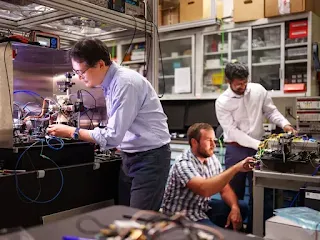The Push to Miniaturize Atom Interferometers for Advanced Motion Sensing
Traditionally, atom interferometers, which are quantum sensors known for their extraordinary sensitivity to motion, are large devices that can fill an entire room. Even the more mobile versions of these sensors are still the size of a mini-refrigerator.
These sensors rely on complex laser systems that are typically the size of a refrigerator and are crucial in driving atoms into states of superposition, a key component of quantum sensing.
To address the challenges of size and practicality, Ashok Kodigala, a research scientist at Sandia National Laboratories in Albuquerque, N.M., and his team have developed a silicon photonic modulator. This device, which controls light in an atom interferometer, is small enough to fit on a microchip. Kodigala notes that this innovation could eventually shrink quantum inertial sensors to the size of a shoebox or smaller, making them far more accessible for various applications.
How Atom Interferometers Work: A Glimpse into Quantum Sensing
Atom interferometers operate based on a quantum effect known as superposition, where atoms can exist in multiple states or locations simultaneously. In these sensors, atoms in Schrödinger’s cat–like states travel along different paths before recombining.
The interference patterns that result from the wave-particle duality of these atoms provide insights into the minute differences in motion experienced along their paths. This capability could make atom interferometers crucial for GPS-free navigation systems, which would be invaluable in environments where GPS signals are unreliable or non-existent, such as underground or underwater.
Advancing GPS-Free Navigation and Climate Mapping
Atom interferometers' high sensitivity to motion, down to billionths or even trillionths of ag, holds great promise for GPS-free navigation. These quantum sensors are not reliant on external signals, making them ideal for situations where GPS systems could be jammed, spoofed, or disrupted by weather conditions.
Beyond navigation, Kodigala highlights the potential of quantum inertial sensors in mapping Earth's gravity from space, which could provide critical data on water movement, ice sheet dynamics, and sea-level changes, contributing significantly to climate analysis.
Innovation in Miniaturization: Silicon Photonic Modulators on a Chip
In their latest study, Kodigala and his colleagues used four newly developed silicon photonic modulators in a laser system on a chip approximately the size of a penny. These modulators are designed to shift the frequency of a single laser, effectively performing the roles that multiple lasers typically play in an atom interferometer.
Notably, the new modulator significantly reduces unwanted sidebands by an unprecedented 47.8 decibels, resulting in a nearly 100,000-fold drop in sideband intensity, which could otherwise disrupt sensor performance.
The Road Ahead: Further Integration and Cost Reduction
The miniaturization of atom interferometer laser systems not only promises to make these sensors more practical for field use but also has the potential to significantly reduce their cost. Kodigala and his team highlight that hundreds of these photonic modulators can be fabricated on a single 8-inch wafer using the same manufacturing processes as computer chips, offering a cost-effective alternative to the bulky, expensive components currently used in conventional atom interferometers.
However, while the team has successfully integrated their new modulators into an atom interferometer, the overall sensitivity of the device does not yet match the best laboratory quantum inertial sensors. Kodigala acknowledges that more work remains to be done in integrating additional photonic components at the chip scale but sees the team's progress as a significant step forward.
Conclusion: A Promising Future for Quantum Motion Sensing
The work of Kodigala and his colleagues represents a pioneering effort in the miniaturization of atom interferometers, making these advanced quantum sensors more practical and affordable for widespread use.
As the team continues to refine their technology, the potential applications for GPS-free navigation and climate mapping could revolutionize industries and contribute to critical advancements in our understanding of the environment. Their findings, detailed in the journal Science Advances on July 10, mark a significant milestone in the field of quantum sensing.











0 Comments